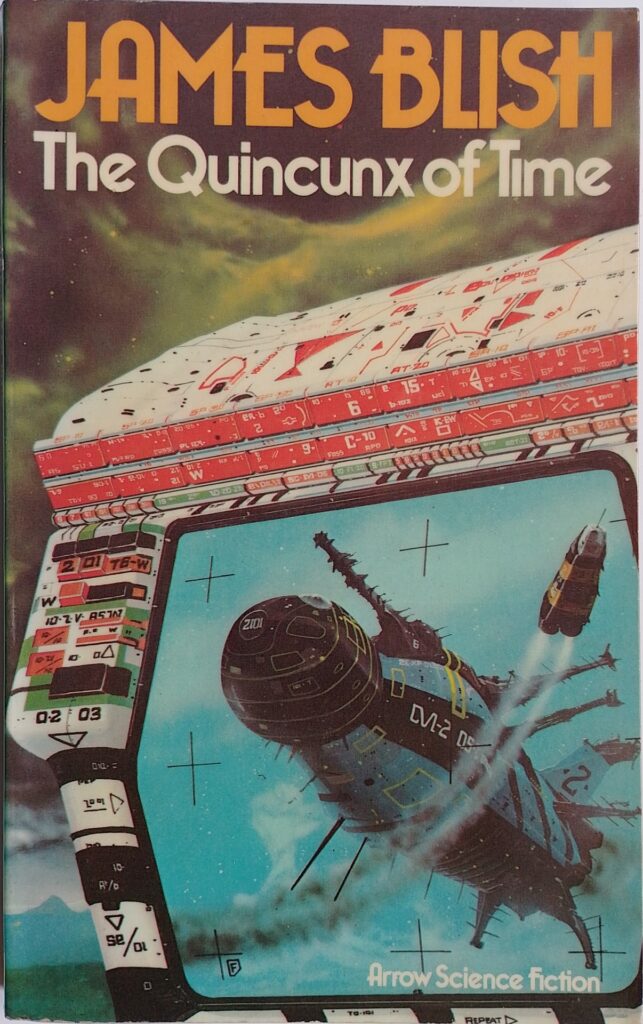First published 1975. Arrow, paperback, 1976, pp 112, c.30,000 words.
Blish was a prolific writer of science fiction short stories. This book was a development of Beep, one he wrote in 1954. That story was seminal because it introduced a device for instantaneous communication over infinite distance – the Dirac Transmitter – much used by later writers like Ursula Le Guin who called it an ‘Ansible’. One of the problems faced by science fiction writers since the establishment of relativity in physics is that nothing in the real world can travel faster than the speed of light, and so sending a message to even the closest star, in the Alpha Centauri system, would take four years. Paul Dirac was one of the most eminent physicists of the twentieth century, clarifying and expanding the fields of quantum mechanics and relativity. He postulated the existence of the positron, a particle that was later shown to exist. Dirac did not develop a faster than light transmitter, and no such device is thought to be possible, although quantum entanglement, Einstein’s ‘spooky action at a distance’, hints that our understanding of the laws of nature is far from complete.
In a ‘Critical Preface’, Blish explains the genesis of the expansion of Beep into the form presented here. He makes no apology for the result being hardly a novel. There is no character development and no real action. It is an exploration of an idea around the nature of time and human free will. ‘The drama lies more in the speculations than in the action’ [p11] he writes. Specifically the idea is: what if all the communications sent by the Dirac Transmitter, both in the past and in the future, could be listened to at any time?
The book is primarily concerned with a conversation between three characters; Robin Weinbaum, head of Earth’s Security Bureau, Thor Wald, the senior physicist in the same organisation, and Dana Lje, an independent video communicator. How prescient is that? She is what we would call a video blogger or V-logger (if that jargon is still current.) A mysterious character, J. Shelby Stevens, has approached Lje, offering his services, claiming that he can predict the future in limited circumstances. Later he starts to shake down the Bureau with the same offer, but demanding vast reward. The sample information he provides turns out to be completely accurate.
The three main characters then engage in a series of debates about how Shelby Stevens is coming by his information and what the consequences are if his claim turns out to be true. Does this mean that we live in a completely deterministic universe, and all our actions are predetermined, and therefore we have no free will? Or do we retain some element of free will because the knowledge of the future is limited to the contents of messages sent using the Dirac Transmitter?
Blish presents this debate in an entertaining way with characters sparring off one another. Most of the time it avoids becoming just a thought experiment. Some spurious physics jargon is thrown in: Hilbert Space, and Gödel’s theorems for example are real, but also some future physicist genius is invented by the name of Haertel, who is set on a par with Einstein, and seems to have overturned much of Quantum Mechanics, but not quite all. Blish wasn’t a physicist, or even a student of physics, but he clearly had a good layman’s understanding of the state of physics when this was written. As always in science fiction it is impossible to completely escape the present. A machine Wald constructs is a ‘gray [sic], crackle-cased burden’ – so redolent of electrical test equipment of the 1950s and ‘60s. Slightly later, Blish says that Lje was confused by one of the knobs on the machine, labelled SYM, which otherwise she understood. Wald then confesses that the machine required eight knobs on one side, but only seven on the other, so he added an extra, functionless one for symmetry.
This is a short, entertaining read. Blish writes fluently, and despite the lack of much physical action, the story bowls along. It is strongly recommended for students of science fiction. Oh yes, I had to look up ‘Quincunx’, and apparently it is a specific pattern of five objects, like the five dots on one of the sides of a dice. I still have no idea how that relates to the book; it just sounds like a great title for a science fiction story.
© William John Graham, August 2022

